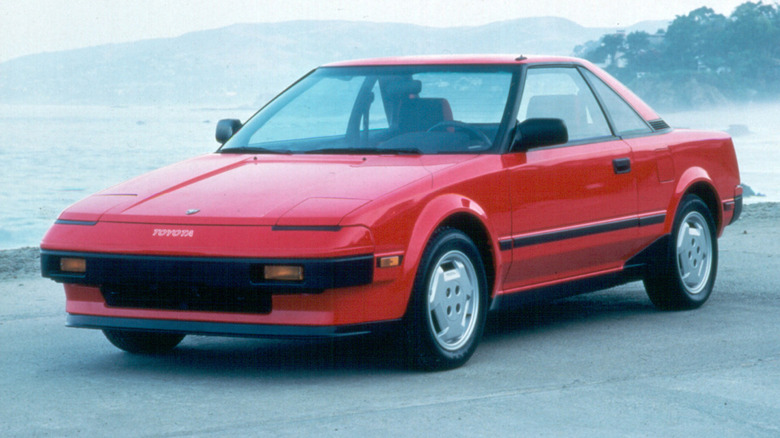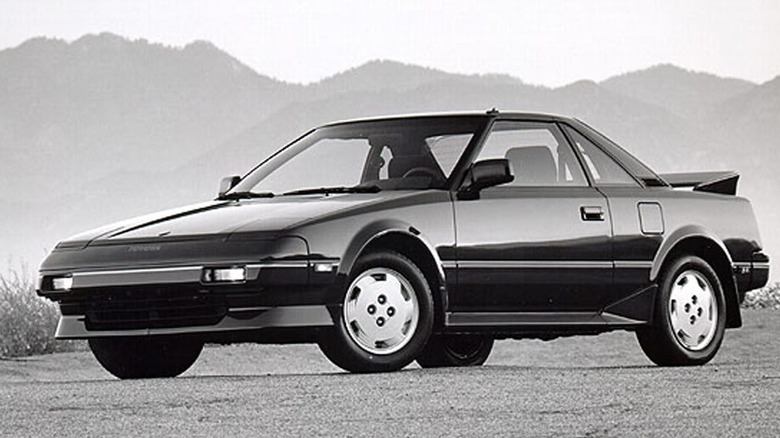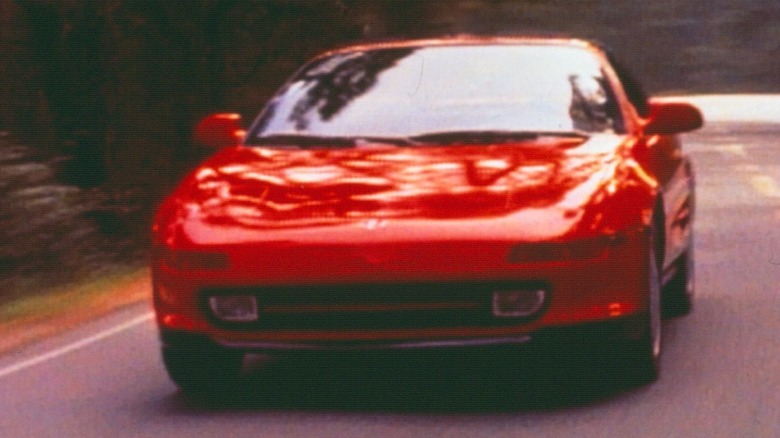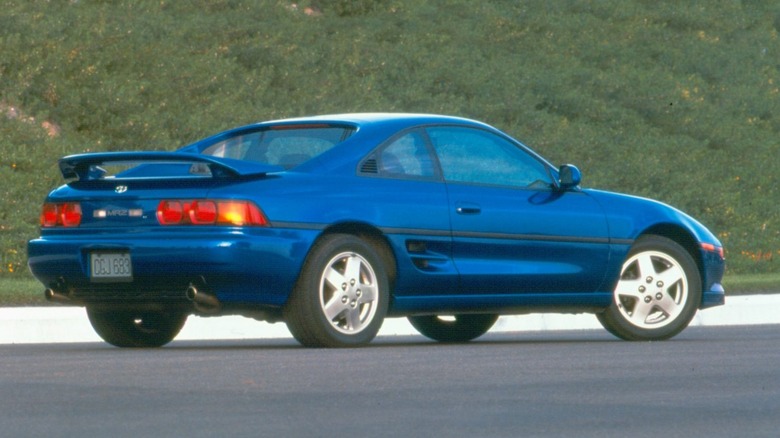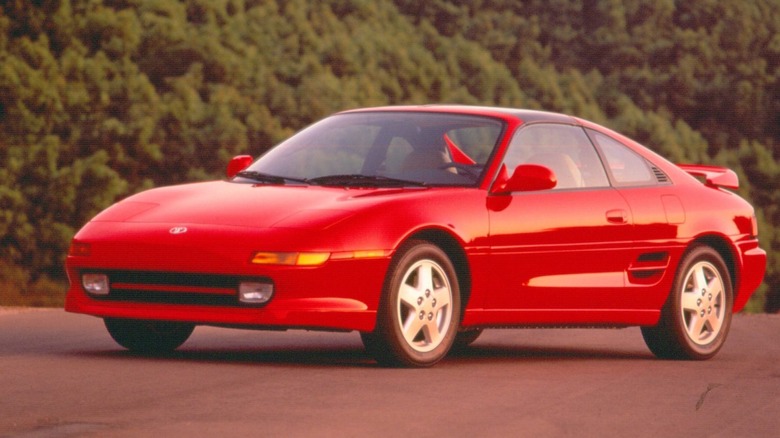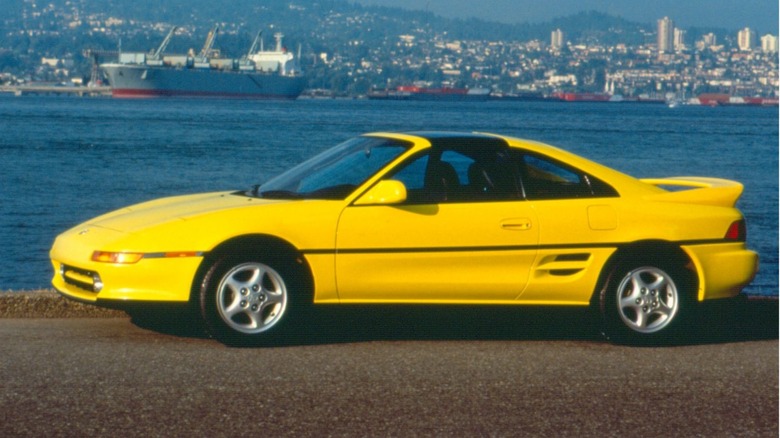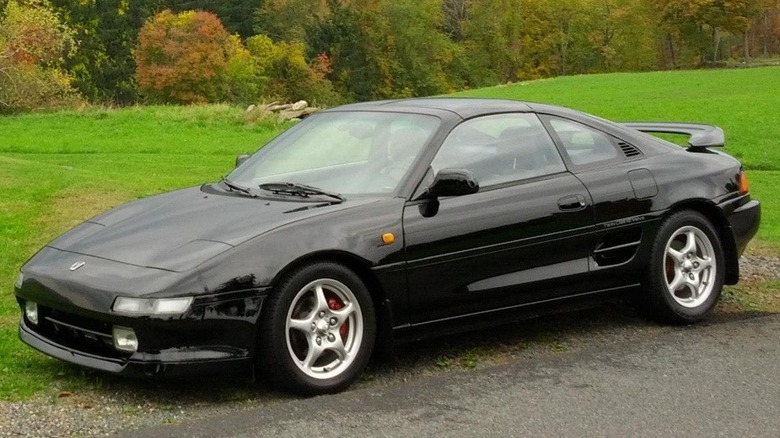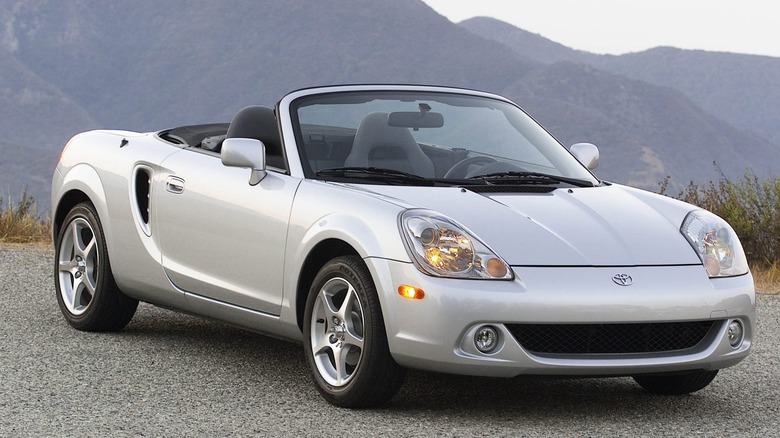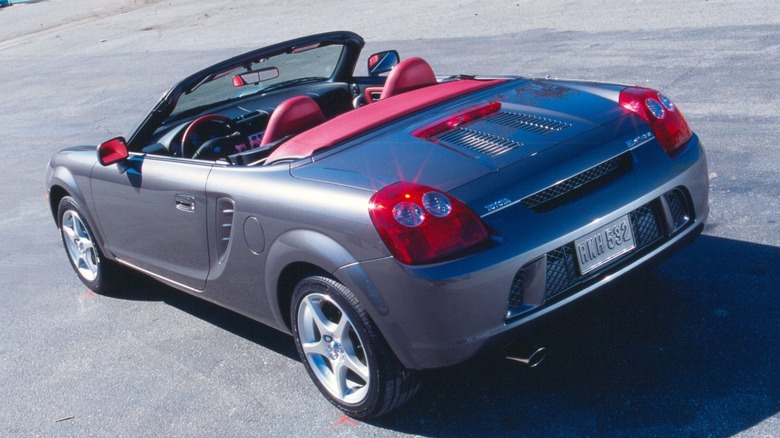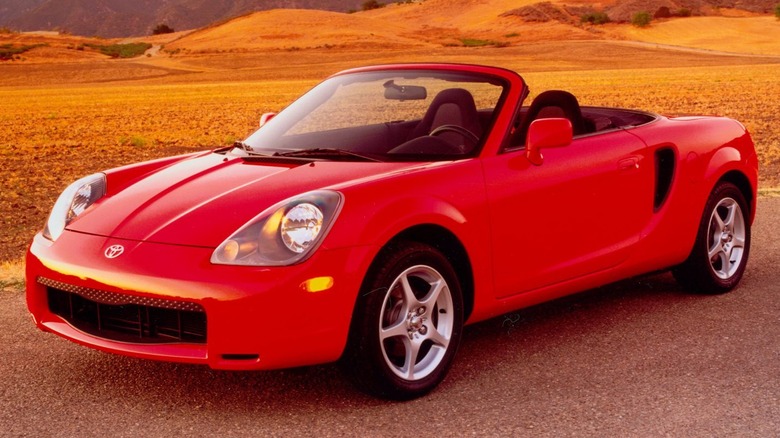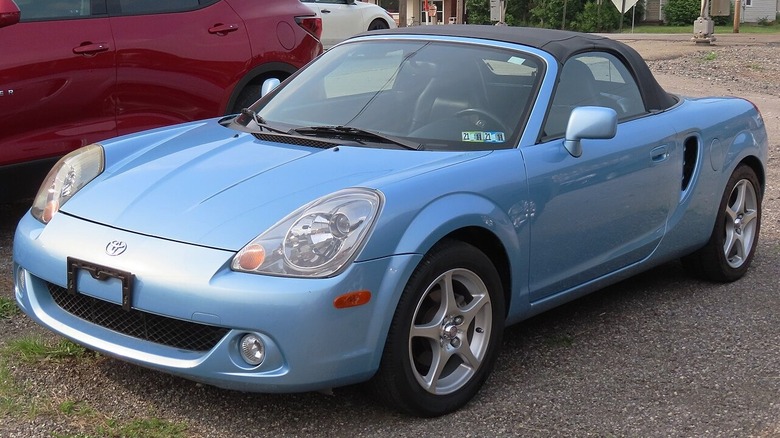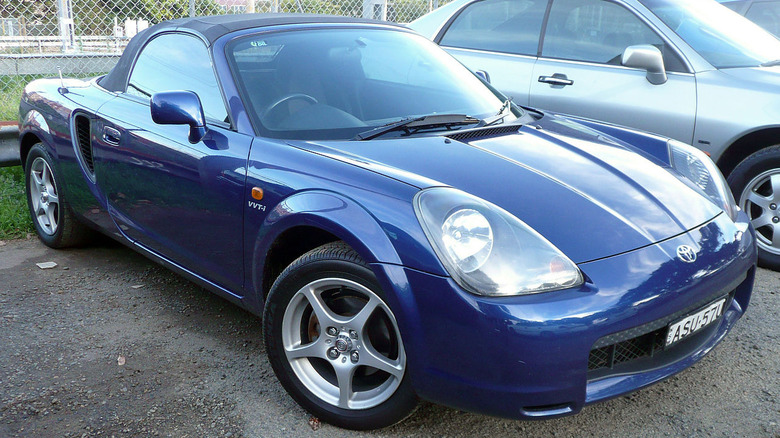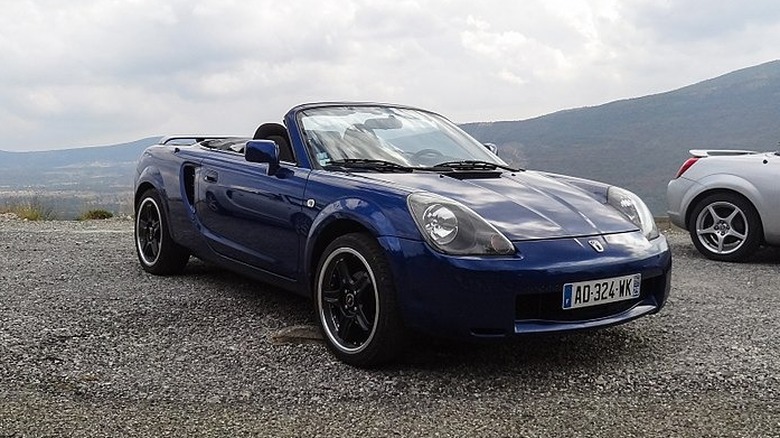12 Of The Best, Most Reliable Years For The Toyota MR2 Mid-Engine Sports Car
Ranking the Toyota MR2 by reliability is a dish best served with disclaimers. Mainly because this iconic mid-engine sports car has carved out a niche of rabid fans who know the various MR2 model years inside and out. But also because the MR2 (an abbreviation that means more than 'Mister Two') is widely considered a very reliable sports car. Then there is the issue of generational divide.
Between 1989 and 2005, the Toyota MR2 saw three distinct generations in North America, and each one was dramatically different than the others. Unlike, say, a Honda Civic that has been sold by the millions, the MR2 is a relatively low-volume vehicle, making hard data on reliability somewhat thin. So, to figure out what the most reliable MR2s are, we've scoured sites with owner-reported commentary like Kelley Blue Book (KBB), mixed in as much data as possible from the NHTSA, and sifted through the colorful language of message boards.
In some cases, there are clear reliability issues to be aware of, but a major factor in this ranking is age. Aside from trailer queens fetching top dollar on auction sites, there's no way around the fact that a 40-year-old Toyota MR2 that has seen regular use from new will simply be more prone to reliability-related problems than an example that is 20 years younger. So, unless Toyota takes our advice to resurrect the beloved MR2, these are currently your best options.
1989 MR2
The final year of first-gen MR2 production, the AW11 series, gets the nod as least reliable simply because it's so much older than the rest of the MR2s here. If we wanted to rank every single MR2 model year by reliability, the very first one in 1985 would have been the pick. It's not to say all 1989 MR2s are unreliable, but to point out that a 36-year-old car with regular use is going to have some pitfalls. Rust is a commonly cited problem with these early MR2s, so if you're in the market, be sure to get a good look at the underside and areas that can trap water, like the trunk.
An upside to these MR2s is that the supercharged models were introduced one year prior, meaning Toyota had time to iron out the kind of wrinkles that often appear with a new model. Boasting iconic angular sheetmetal and a functional air intake on the right side, there's no denying the '80s cool factor of the first-gen MR2. Factor in the early MR2's reputation for being fun to drive, agile, and quick, and these early Toyota MR2s have a lot to offer. Just do your homework before buying one.
1991 MR2
The second-generation SW20 series debuted in 1991. Generally, it is a highly regarded series due to its 'Baby Ferrari' design, relatively spacious cockpit, and more potent powertrains. Those pop-up headlights are pretty sweet, too. However, it's no secret that the first year of any new generation is best avoided as the automaker typically needs time to work through unexpected issues. As well, these early SW20s came with transmission synchros described by Hagerty as "crunchy", an issue that was addressed later in production.
Though not reliability-related, the potentially scary situation of lift-off snap oversteer is also something to be aware of. As it sounds, sudden lifting of the accelerator in a corner could cause sudden oversteer, a problem that was later corrected via suspension redesign. Given how closely spaced all MR2s are in terms of reliability, this problem was a factor in pushing the 1991 model further down the list. It also cannot avoid the likely issues that crop up when a car is more than 30 years old. All that said, the few owner reviews available are mainly positive and include commentary like "amazingly well-built". So don't dismiss the 1991 MR2 out of hand, just be aware of these potential pitfalls.
1992 MR2
One year more advanced than the second-gen MR2 debut, the 1992 models are already in better standing than 1991 examples. The exciting oversteer condition still stands with these Mister Twos. Like any model from the SW20 generation, the tuner community is known for getting a bit wild with modifications. Watch out for wacky body kits, steeply angled camber, and overly loud exhaust systems. When it comes to buying a reliable old car like this, originality is best as it avoids the potential for poorly installed upgrades.
In good news, several owners who commented on KBB rate these MR2s positively when it comes to reliability, and 93 percent of all owners would recommend it. Only a single owner on Edmunds gave it a negative review, but issues cited ranged from a leaking T-top and gas tank to clutch failure. Over at Cars.com, reliability comes in at 5 out of 5, but there were only two reviews to lean on. These 1992 MR2s could be had with a 130-horse naturally aspirated four-cylinder or a turbocharged version making 200 hp. The latter is obviously an enthusiast favorite. Just be sure to do a thorough inspection of the turbocharger system as parts availability can be an issue today.
1993 MR2
The 1993 MR2 Turbo is a favorite in the Reddit community, with one owner reporting over 200,000 miles on their example. Given its age, these MR2s are about mid-pack on this list of the most reliable MR2s. But among the SW20 generation, it's important to note that in 1993, Toyota made a host of changes to the MR2 aimed at correcting the lift-off snap oversteer issue. That included changing the rear suspension geometry, increasing the wheel size from 14 to 15 inches, and offering an optional limited-slip differential.
On top of that, the transmission synchronizers were overhauled to eliminate complaints from earlier second-gen models. A larger front lip spoiler added a bit of pizazz, and on the reliability front, the 1993 MR2 acquits itself nicely. Every owner who left a review on Edmunds had nothing but positive things to say, like, "Mine has been trouble-free..." and these MR2s earned a 4.8 out of 5 for reliability per KBB owner reviews. These are still old cars that are suited to DIYers and should be assumed to require semi-regular maintenance, but most owners seem to agree that the 1993 MR2 is otherwise a solid mid-engine sports car.
1995 MR2
After 1995, Toyota discontinued MR2 production for North America due to exchange rate challenges at the time. As a result, it's estimated that fewer than 300 examples were sold in the market that year. Though largely similar to the 1994 MR2, such a small volume means finding one 30 years later is that much harder. This has nothing to do with reliability, but when it comes to splitting hairs on this subject, a difficult-to-source model ranks lower than one with a larger pool to pull from. Another aspect of that limited production is a dearth of data.
There are just two apparent owner-reported reviews on these 1995 MR2s that have to do with reliability, and both are positive, with one noting, "Toyota reliability and build is legendary." One potential issue of note with these MR2s is the higher cost of maintenance required when it comes time to replace suspension and brake components that were upgraded with the 1993 model year. Aside from that, keep an eye out for signs of leaky T-tops, interior door lock mechanism failure, and prematurely worn hydraulic clutch components.
1994 MR2
Every second-gen Toyota MR2 receives praise for its sleek good looks and more planted stance from the longer and wider body versus the first-gen models. All of which Toyota enhanced in 1994 by refreshing the exterior, updating the taillight design, and redesigning the rear spoiler. Ultimately, all of the SW20 MR2s sit lower in our reliability rankings than the final generation because of age, and parts availability is another challenge with owning these MR2s. However, these models do fare well in reliability with nothing but positive praise from owners, such as "...smooth, reliable, and most of all FAST!!!"
Additionally, the 1994 MR2 received a 5-horsepower bump in output on the base engine, along with a passenger-side airbag and overhauled ABS and power steering systems. With a higher production volume than the 1995 model, prospective buyers should have an easier time finding one versus the final model year. They should, however, be aware that finding a mechanic to work on one may be tough, so plan on doing your own repairs, and you should have good luck with these second-gen MR2s.
2000 MR2 Spyder
After a 4-year hiatus, Toyota's mid-engine sports car returned in 2000 with a new moniker, the MR2 Spyder. Dramatically different from a styling perspective than its predecessors, the W30 generation became one of the few convertibles ever made by Toyota. Though the new looks were polarizing, these MR2s have earned a reputation as the poor man's Porsche Boxster, which is high praise indeed. As for reliability, even these oldest of third-gen MR2s are 25 years old, so age-related issues may be less severe than in the previous generations. Much like the 1991 model year, the 2000 MR2 Spyder gets dinged simply for being the first run of a new series out of the factory.
Some commonly reported problems that came with early W30 MR2s are excessive oil consumption, O2 sensors failing too soon, and issues with parking brake cables. Toyota did not sell the third-gen MR2 with any kind of forced induction, so the inherent powertrain stress of turbos and superchargers is not a factor here. There are also many glowing reviews from owners on Edmunds and Cars.com regarding reliability. If you can get past the polarizing styling, a 2000 MR2 Spyder has a lot to offer, but you may be better off looking to later model years from this generation.
2002 MR2 Spyder
For 2002, Toyota introduced a new five-speed sequential manual transmission (SMT), essentially a shiftable automatic transmission, as an option on the MR2. Several owners logged complaints about this transmission with the NHTSA, and according to an owner review on Edmunds, the transmission failed just 2 months after purchase. That same reviewer noted rapid failure of both catalytic converters and strange engine noises, so it's possible the particular example was an outlier. As well, the NHTSA only has MR2 data from 2002 to 2004, so it cannot be used as a sole reason to avoid these MR2 Spyders.
The NHTSA also lists complaints related to a seized engine, in addition to catalytic converter problems, which emerged at 118,000 miles. These could be long-term teething problems with manufacturing, as this was only the second year of an all-new model. That said, most owner reviews about reliability on Edmunds are positive, and Cars.com gives these MR2s a 5 out of 5 for the metric. At the very least, it's probably worth avoiding 2002 Mister Twos fitted with the five-speed SMT and really, if this is the poor man's Boxster, a traditional manual transmission is the way to go.
2001 MR2 Spyder
The 2001 MR2 Spyder edges out the 2002 model because its owner-reported reliability is a bit better. From over 169 reviews on KBB, only 2% placed it beneath 4 stars, and 98% would recommend the car, noting that performance and quality are the best features. Similar results can be found at Edmunds and Cars.com with commentary like, "Never a day of trouble". Of course, faults can be found, such as one owner who had gone through three transmissions and two engines, but mass-produced vehicles have outlying issues, no matter the year and make.
The reviews reinforce the idea that with any well-loved car, MR2 or otherwise, it's critical to look for the best-kept example possible, ideally with a detailed service history, and evidence of prior owners that took good care of the car. These early models did suffer from excessive oil consumption, and it's important to investigate the condition of the convertible soft-top carefully. But with Toyota's well-known reputation for reliability, there seem to be ample reason to consider the 2001 MR2 Spyder.
2003 MR2 Spyder
Issues with the SMT remain at the forefront of 2003 MR2 Spyder reliability concerns. Toyota added a gear, for a total of six, but multiple complaints have been logged with the NHTSA regarding this powertrain. Other one-off consumer complaints with the safety agency for this car include unexpected acceleration and a sudden loss of power. As previously noted, with limited data points, it is challenging to pinpoint a single issue as the primary reason for avoiding car purchases. This is part of the reason the 2003 MR2 gets the nod as the third most reliable model year.
Yes, there are a handful of seemingly major issues at play, but not enough of a trend to derail its overall quality. For one thing, these MR2s are relatively young at 22 years old, and every year counts when it comes to buying an older vehicle. For another, the 2003 MR2 Spyder gets top marks from consumers on reliability from our available sources. As for the enthusiasts out there, Toyota bumped the wheels up from 15 to 16 inches, retuned the suspension, and revised the styling of the 2003 Mister Two, making it a fairly desirable mid-engine sports car.
2004 MR2 Spyder
In theory, it's easier to find a used car in good condition the younger it is, which is partly why the 2004 MR2 places ahead of its 2003 stablemate here. Additionally, fewer concerns with the sequential manual transmission arose at the NHTSA for the '04 model year. The lone Edmunds reviewer was "...impressed with the quality of craftsmanship," and these models earn a 4.8- out of 5-star ranking for reliability with Cars.com. Though not related to reliability, it's worth knowing that Toyota upgraded the structure of the 2004 MR2 Spyder to improve crash protection.
The automaker also added an optional Torsen limited-slip differential for MR2s with a manual transmission, a feature sure to please the enthusiast set. Though relatively young, these MR2 Spyders have still been on the road for more than two decades, so be sure to check for rust, particularly if the car spent time in snowy climes. And like any of the W30 generation cars, the soft convertible top can wear out if not taken care of. But, for the most part, it seems the 2004 Toyota MR2 Spyder is a rather reliable sports car.
2005 MR2 Spyder
Our pick for the most reliable Toyota MR2 is the final model to see North American shores. The reasons behind why the MR2 was discontinued are a story for another day, but for American consumers, 2005 marked the end of the road. The only major update was the addition of a standard six-disc CD changer, but otherwise, these MR2s represent the tail-end of third-gen production. That's a boon to reliability, as Toyota had been manufacturing the W30 series for many years leading up to this, allowing it to close out any niggling issues.
That's borne out by the 100% positive reliability-related owner reviews for the 2005 MR2 on Edmunds and Cars.com. There is a single complaint related to the transmission with the NHTSA, but technically, that's the fewest recorded concerns on this front. Only 780 MR2 Spyders were sold in 2005, so finding one could be tricky. But given these are the youngest Toyota Mister Twos currently available, unless Toyota really does bring back the MR2 and the list of concerns is so short, it gets the nod as the most reliable MR2 of all.
Methodology
To create this list of the most reliable Toyota MR2 models, we analyzed owner-posted reliability reviews from Edmunds, Kelley Blue Book, and Cars.com. We also looked at owner-posted complaints with the NHTSA and scoured Reddit forums for MR2 owner feedback on reliability. Model years were ranked based on available reliability scores, age, and known issues.
